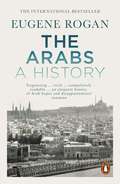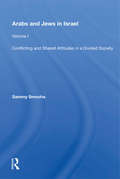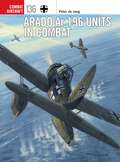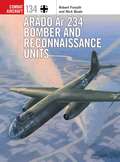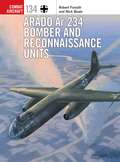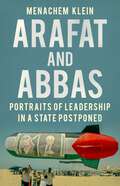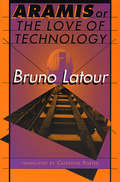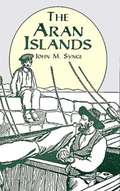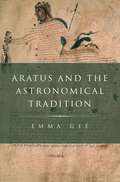- Table View
- List View
The Arabs: A History – Third Edition
by Eugene RoganEugene Rogan has written an authoritative new history of the Arabs in the modern world. Starting with the Ottoman conquests in the sixteenth century, this landmark book follows the story of the Arabs through the era of European imperialism and the Superpower rivalries of the Cold War, to the present age of unipolar American power. Drawing on the writings and eyewitness accounts of those who lived through the tumultuous years of Arab history, The Arabs balances different voices - politicians, intellectuals, students, men and women, poets and novelists, famous, infamous and the completely unknown - to give a rich, complex sense of life over nearly five centuries.Rogan's book is remarkable for its geographical sweep, covering the Arab world from North Africa through the Arabian Peninsula, and for the depth in which it explores every facet of modern Arab history. Charting the evolution of Arab identity from Ottomanism to Arabism to Islamism, it covers themes including the conflict between national independence and foreign domination, the Arab-Israeli struggle and the peace process, Abdel Nasser and the rise of Arab Nationalism, the political and economic power of oil and the conflict between secular and Islamic values.This multilayered, fascinating and definitive work is the essential guide to understanding the history of the modern Arab world - and its future.
Arabs and Empires before Islam
Arabs and Empires before Islam illuminates the history of the Arabs before the emergence of Islam, collating nearly 250 translated extracts from an extensive array of ancient sources. Drawn from a broad period between the eighth century BC and the Middle Ages, the sources include texts originally written in Greek, Latin, Syriac, Persian, and Arabic, inscriptions in a variety of languages and alphabets, and discussions of archaeological sites from across the Near East. More than twenty international experts from the fields of archaeology, classics and ancient history, linguistics and philology, epigraphy, and art history provide detailed commentary on and analysis of this diverse selection of material. Richly illustrated with sixteen colour plates, fifteen maps, and over seventy in-text images, the volume provides a comprehensive, wide-ranging, and up-to-date examination of what ancient sources had to say about the politics, culture, and religion of the Arabs in the pre-Islamic period. It offers a full consideration of the traces which the Arabs have left in the epigraphic, literary, and archaeological records, and sheds light on their relationship with their often more-powerful neighbours: the states and empires of the ancient Near East. Arabs and Empires before Islam gathers together a host of material never before collected into a single volume - some of which appears in English translation for the very first time - and provides a single point of reference for a vibrant and dynamic area of research.
Arabs and Iranians in the Islamic Conquest Narrative: Memory and Identity Construction in Islamic Historiography, 750–1050 (Culture and Civilization in the Middle East)
by Scott SavranArabs and Iranians in the Islamic Conquest Narrative analyzes how early Muslim historians merged the pre-Islamic histories of the Arab and Iranian peoples into a didactic narrative culminating with the Arab conquest of Iran. This book provides an in-depth examination of Islamic historical accounts of the encounters between representatives of these two peoples that took place in the centuries prior to the coming of Islam. By doing this, it uncovers anachronistic projections of dynamic identity and political discourses within the contemporaneous Islamic world. It shows how the formulaic placement of such embellishment within the context of the narrative served to justify the Arabs’ rise to power, whilst also explaining the fall of the Iranian Sasanian empire. The objective of this book is not simply to mine Islamic historical chronicles for the factual data they contain about the pre-Islamic period, but rather to understand how the authors of these works thought about this era. By investigating the intersection between early Islamic memory, identity construction, and power discourses, this book will benefit researchers and students of Islamic history and literature and Middle Eastern Studies.
Arabs and Iranians in the Islamic Conquest Narrative: Memory and Identity Construction in Islamic Historiography, 750–1050 (Culture and Civilization in the Middle East)
by Scott SavranArabs and Iranians in the Islamic Conquest Narrative analyzes how early Muslim historians merged the pre-Islamic histories of the Arab and Iranian peoples into a didactic narrative culminating with the Arab conquest of Iran. This book provides an in-depth examination of Islamic historical accounts of the encounters between representatives of these two peoples that took place in the centuries prior to the coming of Islam. By doing this, it uncovers anachronistic projections of dynamic identity and political discourses within the contemporaneous Islamic world. It shows how the formulaic placement of such embellishment within the context of the narrative served to justify the Arabs’ rise to power, whilst also explaining the fall of the Iranian Sasanian empire. The objective of this book is not simply to mine Islamic historical chronicles for the factual data they contain about the pre-Islamic period, but rather to understand how the authors of these works thought about this era. By investigating the intersection between early Islamic memory, identity construction, and power discourses, this book will benefit researchers and students of Islamic history and literature and Middle Eastern Studies.
Arabs and Israelis: Conflict and Peacemaking in the Middle East
by Abdel Monem Aly Shai Feldman Khalil ShikakiThoughtful and innovative in its approach, this textbook provides a balanced overview of one of the most protracted and bitter struggles of modern times: the Arab-Israeli conflict. It sets out to relay basic information on the evolution of the conflict and explore the efforts to resolve it, and then goes on to portray the differing perspectives of each of the important parties. Written by a distinguished team of leading scholars, the book outlines key developments in the history of the conflict without imposing propagandistic ideas. It places the events of the conflict within a regional and international context, making it an invaluable insight into the opposing narratives that have fuelled the conflict for so long.This is essential reading for students, academics and policy-makers wishing to understand the history and politics of the Arab-Israeli conflict and its pivotal role in the Middle East, and will be sure to enlighten those who are new to what is considered to be a highly contentious subject, as well as encourage critical thinking and discussion.
Arabs and Israelis: Conflict and Peacemaking in the Middle East
by Abdel Monem Aly Shai Feldman Khalil ShikakiLasting over 120 years, the Arab-Israeli conflict involves divergent narratives about history, national identities, land ownership, injustices and victimhood. Domestic forces and actors as well as international and regional dynamics have ensured the conflict's durability.A distinguished team of authors comprising an Israeli, a Palestinian and an Egyptian present a broader Arab perspective in this innovative textbook that offers a balanced and nuanced introduction to a highly contentious subject. Providing an overview of key developments in the history of the conflict, it explores attempts at resolution, before going on to portray the perspectives of the important parties. It places the events of the conflict within a regional and international context, providing an invaluable insight into the opposing narratives behind the conflict.The much-anticipated second edition of Arabs and Israelis includes:- Up-to-date coverage of key developments since the Arab Awakening, including the shifting pattern in relations from Obama to Trump, the Abraham Accords, the fall of Netanyahu and the resurgence of the war in early 2021.- Brand new 'Key Developments', 'Key Documents' and 'Key Figures' feature boxes to help students zoom in on landmark events, policies and actors throughout history.- Detailed full colour maps, timelines and photos to visually complement the text.- A rich companion website including interactive timelines and maps, discussion questions, chapter summaries and more.A comprehensive and engaging account of the Arab-Israeli conflict, it is the ideal companion for students at undergraduate and postgraduate level taking History, Politics and Middle Eastern Studies degrees.
Arabs and Israelis: Conflict and Peacemaking in the Middle East
by Abdel Monem Aly Shai Feldman Khalil ShikakiLasting over 120 years, the Arab-Israeli conflict involves divergent narratives about history, national identities, land ownership, injustices and victimhood. Domestic forces and actors as well as international and regional dynamics have ensured the conflict's durability.A distinguished team of authors comprising an Israeli, a Palestinian and an Egyptian present a broader Arab perspective in this innovative textbook that offers a balanced and nuanced introduction to a highly contentious subject. Providing an overview of key developments in the history of the conflict, it explores attempts at resolution, before going on to portray the perspectives of the important parties. It places the events of the conflict within a regional and international context, providing an invaluable insight into the opposing narratives behind the conflict.The much-anticipated second edition of Arabs and Israelis includes:- Up-to-date coverage of key developments since the Arab Awakening, including the shifting pattern in relations from Obama to Trump, the Abraham Accords, the fall of Netanyahu and the resurgence of the war in early 2021.- Brand new 'Key Developments', 'Key Documents' and 'Key Figures' feature boxes to help students zoom in on landmark events, policies and actors throughout history.- Detailed full colour maps, timelines and photos to visually complement the text.- A rich companion website including interactive timelines and maps, discussion questions, chapter summaries and more.A comprehensive and engaging account of the Arab-Israeli conflict, it is the ideal companion for students at undergraduate and postgraduate level taking History, Politics and Middle Eastern Studies degrees.
Arabs And Jews In Israel: Volume 1, Conflicting And Shared Attitudes In A Divided Society
by Sammy SmoohaOn December 9, 1987, the Palestinians on the West Bank and Gaza Strip launched the most serious challenge in this century to non-Arab rule in the area West of the Jordan river. A genuine grassroots movement against protracted occupation and for self-determination, the Intifadeh has already inflicted many losses and scored many gains. By the first anniversary of the uprising, the toll for the revolting Palestinians was at least 280 dead, 4,000 wounded, 5,500 detainees, and some deportations and house demolitions. The substantial suffering and privations also entailed numerous beatings, curfews, arrests, searches, cuts in basic services, closings of schools, and losses of income. The Israelis have had 10 killed, 1,150 wounded, a minimum of a 1.5% drop in the Gross National Product, the stress of a people's,army fighting civilians of an occupied nation, increased international isolation and censure, and the straining of relations with the Diaspora.
Arabs And Jews In Israel: Volume 1, Conflicting And Shared Attitudes In A Divided Society
by Sammy SmoohaOn December 9, 1987, the Palestinians on the West Bank and Gaza Strip launched the most serious challenge in this century to non-Arab rule in the area West of the Jordan river. A genuine grassroots movement against protracted occupation and for self-determination, the Intifadeh has already inflicted many losses and scored many gains. By the first anniversary of the uprising, the toll for the revolting Palestinians was at least 280 dead, 4,000 wounded, 5,500 detainees, and some deportations and house demolitions. The substantial suffering and privations also entailed numerous beatings, curfews, arrests, searches, cuts in basic services, closings of schools, and losses of income. The Israelis have had 10 killed, 1,150 wounded, a minimum of a 1.5% drop in the Gross National Product, the stress of a people's,army fighting civilians of an occupied nation, increased international isolation and censure, and the straining of relations with the Diaspora.
The Arabs and the Holocaust: The Arab-Israeli War of Narratives
by Gilbert AchcarThe Arab-Israeli conflict goes far beyond the wars waged on Middle East battlefields. There is also a war of narratives revolving around the two defining traumas of the conflict: the Holocaust and the Nakba. One side is charged with Holocaust denial, the other with exploiting a tragedy while denying the tragedies of others. In this path-breaking book, political scientist Gilbert Achcar explores these conflicting narratives and considers their role in today's Middle East dispute. He analyzes the various Arab responses to the Holocaust, from the earliest intimations of the genocide, through the creation of Israel and the occupation of Palestine, and up to our own time, critically assessing the political and historical context for these responses. Achcar offers a unique ideological mapping of the Arab world, in the process defusing an international propaganda war that has become a major stumbling block in the path of Arab-Western understanding. 'A magisterial study of breath-taking empathy, examining one of the most painful and emotion-laden topi in the modern world with dispassion, sensitivity and high erudition' Rashid Khalidi, Edward Said Professor of Modern Arab Studies, Columbia University 'An erudite, perceptive, and highly original study' Avi Shlaim 'A fascinating, subtle and original analysis of Israeli and Arab historical narratives' Simon Sebag Montefiore, BBC History Magazine 'This exhaustive survey of Arabic sources is particularly important in correcting the many distortions circulated by polemicists seeking to paint Arabs and Muslims as anti-Semites.' Eugene Rogan, Times Literary Supplement 'A refreshing and original study, showing clearly that Muslim anti-Semitism is neither universal, nor inevitable, nor subject to pat explanations.' The Economist
The Arabs at War in Afghanistan
by Mustafa Hamid Leah FarrallA former senior mujahidin figure and an ex-counter-terrorism analyst cooperating to write a book on the history and legacy of Arab-Afghan fighters in Afghanistan is a remarkable and improbable undertaking. Yet this is what Mustafa Hamid, aka Abu Walid al-Masri, and Leah Farrall have achieved with the publication of their ground-breaking work. The result of thousands of hours of discussions over several years, The Arabs at War in Afghanistan offers significant new insights into the history of many of today's militant Salafi groups and movements. By revealing the real origins of the Taliban and al-Qaeda and the jostling among the various jihadi groups, this account not only challenges conventional wisdom, but also raises uncomfortable questions as to how events from this important period have been so badly misconstrued.
The Arabs at War in Afghanistan
by Mustafa Hamid Leah FarrallA former senior mujahidin figure and an ex-counter-terrorism analyst cooperating to write a book on the history and legacy of Arab-Afghan fighters in Afghanistan is a remarkable and improbable undertaking. Yet this is what Mustafa Hamid, aka Abu Walid al-Masri, and Leah Farrall have achieved with the publication of their ground-breaking work. The result of thousands of hours of discussions over several years, The Arabs at War in Afghanistan offers significant new insights into the history of many of today's militant Salafi groups and movements. By revealing the real origins of the Taliban and al-Qaeda and the jostling among the various jihadi groups, this account not only challenges conventional wisdom, but also raises uncomfortable questions as to how events from this important period have been so badly misconstrued.
Arabs, Politics, and Performance (ISSN)
by Samer Al-Saber Roaa Ali George PotterThis book is a ground-breaking collection on contemporary Arab theatre.Through three sections discussing occupation and resistance, diaspora, migration, and refugees, and nationalism and belonging, this study provides nuanced responses to the contested points of intersection between Arab culture and the West, as well as many of the major concerns within contemporary Arab theatre. The collection draws together scholars from the Middle East, North Africa, Europe, and the United States who write about Arab theatre and the representation of Arabs on European and American stages. It introduces concerns in contemporary Arab theatre, the regions in which Arab theatre is performed, and the issues with representations of Arabs onstage.This volume will be of great significance for those interested in expanding the range of global, postcolonial, African, Asian, or diasporic theatre that they study, teach, or stage.
Arabs, Politics, and Performance (ISSN)
This book is a ground-breaking collection on contemporary Arab theatre.Through three sections discussing occupation and resistance, diaspora, migration, and refugees, and nationalism and belonging, this study provides nuanced responses to the contested points of intersection between Arab culture and the West, as well as many of the major concerns within contemporary Arab theatre. The collection draws together scholars from the Middle East, North Africa, Europe, and the United States who write about Arab theatre and the representation of Arabs on European and American stages. It introduces concerns in contemporary Arab theatre, the regions in which Arab theatre is performed, and the issues with representations of Arabs onstage.This volume will be of great significance for those interested in expanding the range of global, postcolonial, African, Asian, or diasporic theatre that they study, teach, or stage.
Arado Ar 196 Units in Combat (Combat Aircraft)
by Peter de JongBeating its biplane rivals in a 1936 Reich Air Ministry design competition, the Arado Ar 196 provided the Kriegsmarine with possibly the best shipborne reconnaissance seaplane of World War II. Replacing the Heinkel He 60 biplane as the standard catapult-launched floatplane embarked on the Kriegsmarine's capital ships, the Ar 196 flew an assortment of combat missions during World War II, including coastal patrol, submarine hunting, light bombing, general reconnaissance and convoy escort sorties. The first vessel to take its Ar 196A-1s to sea was the pocket battleship Graf Spee, which embarked two in the autumn of 1939. The battleships Bismarck and Tirpitz could carry six Arados each, the battlecruisers Gneisenau and Scharnhorst four and smaller pocket battleships and cruisers two. Shore-based aircraft were also operated from coastal ports on the Channel, Baltic, North Sea and Bay of Biscay coasts, as well as in the Balkans and Mediterranean. In this title, supported by an excellent selection of photographs and full-colour illustrations, Peter de Jong explores the history of the Arado Ar 196, detailing their development and assessing the combat capabilities of one of the last fighting seaplanes.
Arado Ar 196 Units in Combat (Combat Aircraft #136)
by Peter de JongBeating its biplane rivals in a 1936 Reich Air Ministry design competition, the Arado Ar 196 provided the Kriegsmarine with possibly the best shipborne reconnaissance seaplane of World War II. Replacing the Heinkel He 60 biplane as the standard catapult-launched floatplane embarked on the Kriegsmarine's capital ships, the Ar 196 flew an assortment of combat missions during World War II, including coastal patrol, submarine hunting, light bombing, general reconnaissance and convoy escort sorties. The first vessel to take its Ar 196A-1s to sea was the pocket battleship Graf Spee, which embarked two in the autumn of 1939. The battleships Bismarck and Tirpitz could carry six Arados each, the battlecruisers Gneisenau and Scharnhorst four and smaller pocket battleships and cruisers two. Shore-based aircraft were also operated from coastal ports on the Channel, Baltic, North Sea and Bay of Biscay coasts, as well as in the Balkans and Mediterranean. In this title, supported by an excellent selection of photographs and full-colour illustrations, Peter de Jong explores the history of the Arado Ar 196, detailing their development and assessing the combat capabilities of one of the last fighting seaplanes.
Arado Ar 234 Bomber and Reconnaissance Units (Combat Aircraft)
by Robert Forsyth Nick BealeWhen the revolutionary twin jet-powered Arado Ar 234 first appeared in the skies over north-west Europe in the summer of 1944, it represented the state-of-the-art in terms of aeronautical and technical development. The Ar 234 was a formidable aircraft – powered by Jumo 004Bs, the same engine used by the Me 262, and with a maximum speed of 735 km/h and range of 1600 km/h, it was very difficult for the Allies to 'catch'. Here was a machine that with its superior speed could operate with impunity as both a bomber and in the reconnaissancerole. As such, the aircraft became the world's first reconnaissance jet, undertaking secret, high-speed, high-altitude observation missions for the German High Command over the Allied beachheads in Normandy and other Allied strongholds. Astonishingly, in September 1944 and as late as 1945, lone Ar 234s conducted reconnaissance flights over British ports and theMediterranean. The aircraft was equally efficient as a jet bomber – although the Ar 234B-2 bomber variant carried no defensive gun armament, it was able to deliver 1000 kg of bombs at high-speed and at either low- or high-level with considerable and devastating accuracy. This highly detailed title from renowned aviation historian Robert Forsyth explores the history of this incredible aircraft, from its development in the early 1940s to its deployment in both reconnaissance and bomber roles throughout the rest of the war. The masterful text is supported by stunning, specially commissioned artwork.
Arado Ar 234 Bomber and Reconnaissance Units (Combat Aircraft)
by Robert Forsyth Nick BealeWhen the revolutionary twin jet-powered Arado Ar 234 first appeared in the skies over north-west Europe in the summer of 1944, it represented the state-of-the-art in terms of aeronautical and technical development. The Ar 234 was a formidable aircraft – powered by Jumo 004Bs, the same engine used by the Me 262, and with a maximum speed of 735 km/h and range of 1600 km/h, it was very difficult for the Allies to 'catch'. Here was a machine that with its superior speed could operate with impunity as both a bomber and in the reconnaissancerole. As such, the aircraft became the world's first reconnaissance jet, undertaking secret, high-speed, high-altitude observation missions for the German High Command over the Allied beachheads in Normandy and other Allied strongholds. Astonishingly, in September 1944 and as late as 1945, lone Ar 234s conducted reconnaissance flights over British ports and theMediterranean. The aircraft was equally efficient as a jet bomber – although the Ar 234B-2 bomber variant carried no defensive gun armament, it was able to deliver 1000 kg of bombs at high-speed and at either low- or high-level with considerable and devastating accuracy. This highly detailed title from renowned aviation historian Robert Forsyth explores the history of this incredible aircraft, from its development in the early 1940s to its deployment in both reconnaissance and bomber roles throughout the rest of the war. The masterful text is supported by stunning, specially commissioned artwork.
Arafat and Abbas: Portraits of Leadership in a State Postponed
by Menachem KleinThis landmark volume presents vivid and intimate portraits of Palestinian Presidents Yasser Arafat and Mahmoud Abbas, revealing the impact these different personalities have had on the struggle for national self-determination. Arafat and Abbas lived in Palestine as young children. Uprooted by the 1948 war, they returned in 1994 to serve as the first and second presidents of the Palestinian Authority, the establishment of which has been the Palestine Liberation Organization's greatest step towards self-determination for the Palestinian nation. Both Arafat and Abbas were shaped by earlier careers in the PLO, and each adopted their own controversial leadership methods and decision-making styles. Drawing on primary sources in Arabic, Hebrew and English, Klein gives special attention to the lesser known Abbas: his beliefs and his disagreements with Israeli and American counterparts. The book uncovers new details about Abbas' peace talks and US foreign policy towards Palestine, and analyses the political evolution of Hamas and Abbas' succession struggle. Klein also highlights the tension between the ageing leader and his society. Arafat and Abbas offers a comprehensive and balanced account of the Palestinian Authority's achievements and failures over its twenty- five years of existence. What emerges is a Palestinian nationalism that refuses to disappear.
Aralorn: Masques And Wolfsbane
by Patricia BriggsAfter an upbringing of proper behaviour and oppressive expectations, Aralorn fled her noble birthright for a life of adventure as a mercenary spy. But her latest mission involves more peril than she ever imagined.Agents of Sianim have asked her to gather intelligence on the increasingly popular and powerful sorcerer Geoffrey ae'Magi. Soon Aralorn comes to see past the man's striking charisma - and into a soul as corrupt and black as endless night. And few have the will to resist the sinister might of the ae'Magi and his minions.So Aralorn, aided by her enigmatic companion, Wolf, joins the rebellion against the ae'Magi. But in a war against a foe armed with the power of illusion, how do you know who the true enemy is - or where he will strike next?This omnibus edition contains the two titles MASQUES and WOLFSBANE.
Aramis, or the Love of Technology
by Bruno LatourBruno Latour has written a unique and wonderful tale of a technological dream gone wrong. As the young engineer and professor follow Aramis' trail--conducting interviews, analyzing documents, assessing the evidence--perspectives keep shifting: the truth is revealed as multilayered, unascertainable, comprising an array of possibilities worthy of Rashomon. The reader is eventually led to see the project from the point of view of Aramis, and along the way gains insight into the relationship between human beings and their technological creations. This charming and profound book, part novel and part sociological study, is Latour at his thought-provoking best.
The Aran Islands
by J. M. SyngePlaywright John M. Synge visited an isolated group of islands west of Ireland, where he drew inspiration from local folklore and anecdotes. This memorable record of Synge's days amid the islanders and their tales of fairies and Celtic heroes offers an enchanting portrait of Irish cultural renaissance.
Ararat in America: Armenian American Culture and Politics in the Twentieth Century (Armenians in the Modern and Early Modern World)
by Benjamin F. AlexanderHow has the distinctive Armenian-American community expressed its identity as an ethnic minority while 'assimilating' to life in the United States? This book examines the role of community leaders and influencers, including clergy, youth organizers, and partisan newspaper editors, in fostering not only a sense of Armenian identity but specific ethnic-partisan leanings within the group's population. Against the backdrop of key geopolitical events from the aftermath of the Armenian Genocide to the creation of an independent and then Soviet Armenia, it explores the rivalry between two major Armenian political parties, the Tashnags and the Ramgavars, and the relationship that existed between partisan leaders and their broader constituency. Rather than treating the partisan conflict as simply an impediment to Armenian unity, Benjamin Alexander examines the functional if accidental role that it played in keeping certain community institutions alive. He further analyses the two camps as representing two conflicting visions of how to be an ethnic group, drawing a comparison between the sociology-of-religion models of comfort religion and challenge religion. A detailed political and social history, this book integrates the Armenian experience into the broader and more familiar narratives of World War I, World War II, and the Cold War in the USA.
Ararat in America: Armenian American Culture and Politics in the Twentieth Century (Armenians in the Modern and Early Modern World)
by Benjamin F. AlexanderHow has the distinctive Armenian-American community expressed its identity as an ethnic minority while 'assimilating' to life in the United States? This book examines the role of community leaders and influencers, including clergy, youth organizers, and partisan newspaper editors, in fostering not only a sense of Armenian identity but specific ethnic-partisan leanings within the group's population. Against the backdrop of key geopolitical events from the aftermath of the Armenian Genocide to the creation of an independent and then Soviet Armenia, it explores the rivalry between two major Armenian political parties, the Tashnags and the Ramgavars, and the relationship that existed between partisan leaders and their broader constituency. Rather than treating the partisan conflict as simply an impediment to Armenian unity, Benjamin Alexander examines the functional if accidental role that it played in keeping certain community institutions alive. He further analyses the two camps as representing two conflicting visions of how to be an ethnic group, drawing a comparison between the sociology-of-religion models of comfort religion and challenge religion. A detailed political and social history, this book integrates the Armenian experience into the broader and more familiar narratives of World War I, World War II, and the Cold War in the USA.
